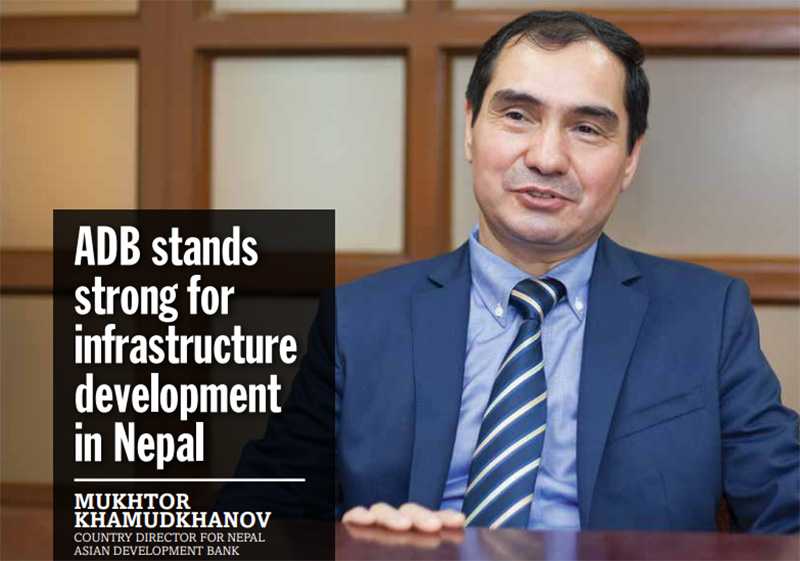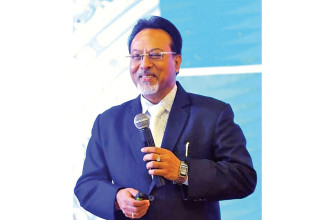

Mukhtor Khamudkhanov, Country Director for Nepal of the Asian Development Bank (ADB) shares that ADB will continue to be a reliable development partner as Nepal endeavours for rapid and higher inclusive economic growth.
Rojina Maharjan of B360 interviews Khamudkhanov to learn more about the status of Nepal’s infrastructure development and ongoing projects like the Melamchi Water Supply Project and Gautam Buddha International Airport funded by ADB, and their plans and policies. Excerpts:
In your two years in Nepal, how do you rate infrastructure development in Nepal?
With the long-awaited political stability and the federal system of governance in place, Nepal is at a historic point with unique opportunity to bring about economic and social transformation. The infrastructure needs of Nepal are huge. Nepal’s infrastructure investment to gross domestic product (GDP) ratio is low. Nepal needs investment in critical physical infrastructure, such as transport, power, telecommunication, and water supply and sanitation to increase productivity and to provide access to social services. Infrastructure such as roads, electricity and telecommunications facilitate the production and distribution of goods and services, including education and health.
Lack of adequate infrastructure services is often a binding constraint to private sector investment, growth and development. However, the recent improvements in the economy and reform initiatives of the government signal progress in creating an enabling environment for private sector investment in infrastructure development. This will help create jobs and further boost growth.
What is the contribution of ADB in infrastructure development since your tenure as Country Director for Nepal? What are the strategies and programs ADB plans to address in infrastructure development?
Since its establishment, the Asian Development Bank (ADB) has provided almost six billion dollars in financial and technical assistance to Nepal. The assistance was provided in energy, transport, water supply and urban infrastructure services, agriculture and irrigation, and education. ADB is currently financing two national pride projects: the Melamchi Water Supply Project and Gautam Buddha International Airport.
To promote inclusive and balanced growth, ADB also invests in the basic needs of people such as rural roads, water supply and sanitation in small towns, microfinance, earthquake-damaged schools, gender and social inclusion, climate change mitigation and adaptation, not to mention leveraging private sector investments in hydropower projects and tourism, etc.
ADB is formulating a new Country Partnership Strategy (CPS) for Nepal covering a five-year (2020–2024) period, for approval in August 2019. The CPS will take into consideration development challenges in Nepal, the strategic objectives and priorities of the government, other development partners’ support to the country, and the best use of ADB’s resources available for the country. Substantive consultations are ongoing with the government agencies at the central, provincial and local levels, international development partners, civil society, and the private sector.
Our focus is on helping the government develop infrastructure and related institutions in energy, transport and urban development, water supply and sanitation; education and skills development, and commercialisation and modernisation of agriculture.
The South Asia Sub-regional Economic Cooperation (SASEC) program is working with Nepal to develop trade infrastructure, laying the foundation for economic growth. Modern trade facilities and services create new opportunities for businesses and make trade more efficient, especially in a landlocked country like Nepal.
What are the projects that have been approved and in progress here?
ADB’s Country Partnership Strategy for Nepal (2013–2017, extended to 2019) identifies infrastructure development as the main priority, with most of the assistance earmarked for energy (hydropower generation, transmission and distribution, and off-grid renewable energy), road and air transport, water and other urban infrastructure, and irrigation. The CPS also supports critical policy, regulatory, and institutional reforms to strengthen sector planning, project implementation, and operation and maintenance.
There are currently 36 ongoing projects for a total amount of 2.8 billion dollars in ADB’s portfolio in Nepal. 72% of this portfolio is in the infrastructure sectors.
The recent projects committed in 2018 include:
i. The Rural Connectivity Improvement Project ($103 million) to upgrade rural roads in five provinces to all-weather standards;
ii. The SASEC Highway Improvement Project ($180 million) to upgrade Kamala-Kanchanpur section (87 kilometers) of the East-West Highway;
iii. Improving disaster resilience of schools in three provinces under the Disaster Resilience of Schools Project ($159 million);
iv. The SASEC Power System Expansion Project- additional financing ($20 million) to help expand power transmission capacity and strengthen distribution networks; and
v. The Urban Water Supply and Sanitation Sector Project ($130 million) to support the expansion of community-managed water supply and sanitation in 20 municipalities.
On April 26, ADB had handed over ADB supported earthquake resistant model school for the community reconstructed Sanjiwani Secondary School in Dhulikhel. What is the status of reconstruction for 154 other such schools?
We were very happy and honoured that Right Honorable Prime Minister of Nepal Mr. K.P. Sharma Oli handed over the newly reconstructed Sanjiwani Secondary School in Dhulikhel to the community at a ceremony on April 24. It was a moment of immense joy for me and my colleagues as we know that a better reconstruction process can strengthen a country’s resilience to natural disasters.
Reconstruction offered us an opportunity to build back better and all the schools reconstructed after the earthquake with ADB support follow better standards, building norms and amenities. The schools are not only safe and earthquake resistant, but also have better facilities.
ADB financial support to Nepal reconstruction totals $382 million. We are helping the government’s efforts to put thousands of children back into schools, return vital government services to earthquake-affected communities, and create jobs and income for families by repairing critical road networks.
ADB is directly financing the reconstruction of 154 such schools badly damaged by the 2015 earthquake under the Earthquake Emergency Assistance Project. A total of 162 schools, including eight schools financed by the Japan Fund for Poverty Reduction administered by ADB and 17 schools co-financed by the United States Agency for International Development, are nearing completion with 90 schools already substantially completed under the project.
Similarly, under this project rehabilitation of 376 km road sections and construction of 288 temporary government office buildings have been completed, 61 additional government buildings repaired, and ongoing rebuilding of 62 other government buildings are nearing completion.
ADB is also supporting reconstruction of additional 174 schools under the Disaster Resilience of Schools Project that has been approved in September 2018.
Tell us about Upper Trisuli 1 Hydro power project…
ADB has recently approved the Upper Trishuli1Project of 216 MW capacity. It’s a non-sovereign (private sector) operation that is being initiated.
What is the status and plans for the second Kathmandu Valley water supply and improvement project?
There are two projects in the pipeline to help improve water supply situation in the Kathmandu Valley: Melamchi Water Supply Project (Phase 2) (MWSP-2) and Second Kathmandu Valley Water Supply Sector Development Program (SKVWSSDP).
The MWSP-2 includes two water diversion tunnels to increase volume of water available in Kathmandu Valley by 340 million liters per day (MLD), expansion of water treatment plant capacity, and social uplift program for communities affected by the water diversion. The SKVWSSDP includes additional investment in distribution network improvement, construction of small water treatment plants for existing KUKL sources, and support to strengthen KUKL.
ADB will not be able to proceed with MWSP-2 until the benefits of MWSP-1 are being enjoyed by KUKL customers. In addition, we apply strict readiness criteria to ensure that the loan is only approved when the funds are actually required for implementation and all permits and approvals (e.g., Environmental Impact Assessment, etc.) have been secured. For MWSP-2, the access road and bridges must be substantially completed before a potential tunnel and head works contractor can be mobilised.
The relevant implementing agency is currently testing the new distribution network financed under ongoing projects using tanker water and Bagmati water during the monsoon. For SKVWSSDP, ADB would like to see progress in strengthening KUKL and successful testing of the existing investments in distribution network improvement before committing additional investments in the network improvements. Preparations are at an advanced stage in terms of designs, bidding documents and safeguards requirements.
What about the Tribhuwan International capacity enhancement investment program?
We are holding discussions with the Government of Nepal, and the discussions are at a preliminary stage at the moment.
How does ADB ensures its roles in monitoring projects for completion on time? How supportive is the Nepal government in this regard?
Projects in Nepal face challenges due to the mountainous topography, remote location of many communities, and limited human resource capacities. We are doing regular monitoring with the executing and implementing agencies but overseeing the implementation of a project, especially those in remote areas, is always challenging for project managers.
We are also testing an innovative model in project monitoring. We have developed a real time monitoring tool that is helping project managers address the multiple challenges of implementing post-disaster emergency projects. This web-based project monitoring information system (MIS) allows project officers to closely follow progress, for example, in school construction following the devastating earthquake that hit Nepal in April 2015. The system is a web application linked with mobile applications for real-time progress tracking, offering a platform for complete information related to the project. Information such as detailed surveys, safeguards, and quality assurance monitoring is embedded, and the system is already fully operational. We are hopeful that this system can be used in other projects as well.
ADB also helped establish a Capacity Development Resource Center (CDRC) in the Nepal Administrative Staff College in November 2015, along with a capacity rating system of executing and implementing agencies’ (EA/IA) key implementation functions, under an ongoing ADB technical assistance. In 2016-2018, CDRC trained 1,341 staff of EAs/IAs on project management, procurement, contract management, environmental and social safeguard, gender, equity and social inclusion and financial management. This has helped to enhance relevant project implementation capacities of EAs and IAs.
ADB and the Ministry of Finance also organise quarterly tripartite portfolio performance review meetings with implementing agencies and concerned line ministries. These meetings are very useful to examine the sector and project specific issues and agree on time bound actions to improve implementation of ADB financed projects in Nepal.
What are some of your learnings having worked so closely with Nepal government? What would you like to see changed?
For ADB-assisted projects, startup delays and low disbursement are a major concern. The speed and quality of implementation needs to be improved to achieve results. But the situation is improving. And the overall performance in disbursement has improved significantly in recent years. I am hopeful of further improvement under ADB’s strong partnership with the government.
It is encouraging to note that the government has taken bold legal and regulatory reforms to promote investment, such as the recently enacted Public Private Partnership (PPP) and Investment Act. However, a lack of investment-ready projects remains one of the key reasons behind low capital investment. On project implementation, we highly commend the government’s initiatives to fast-track the execution of national priority projects.
Nepal has now transitioned into the federal system of governance, but challenges remain. To fully unleash the potential of the federal system, clarity in the mandates and responsibilities of different levels of government, more resources for sub-national governments to perform, reforms of state-owned enterprises, enhancement of government agencies’ capacity, and coordination among the three tiers of the government under the framework of national plans, are critical.
How satisfied is ADB with collaborations and achievements so far?
Since the last 50 years, ADB has been privileged to partner with Nepal in its endeavour to achieve inclusive and sustainable growth. That effort entered a new stage in November 1989 when ADB opened its Nepal Resident Mission in Kathmandu. It has been a fruitful partnership as we continue to work together to make the lives of Nepali people better.
ADB has provided almost six billion dollar in financial and technical assistance to Nepal over the years. The results of these investments in partnership with the Government of Nepal are clearly visible. Today, clean energy makes up a substantial proportion of the total energy generation capacity; access to energy for households has improved considerably; road and air transportation networks have expanded; and water supply and sanitation in rural settlements and urban centers have improved along with access to primary education. Investments in irrigation and agriculture have provided better livelihoods for rural communities.







